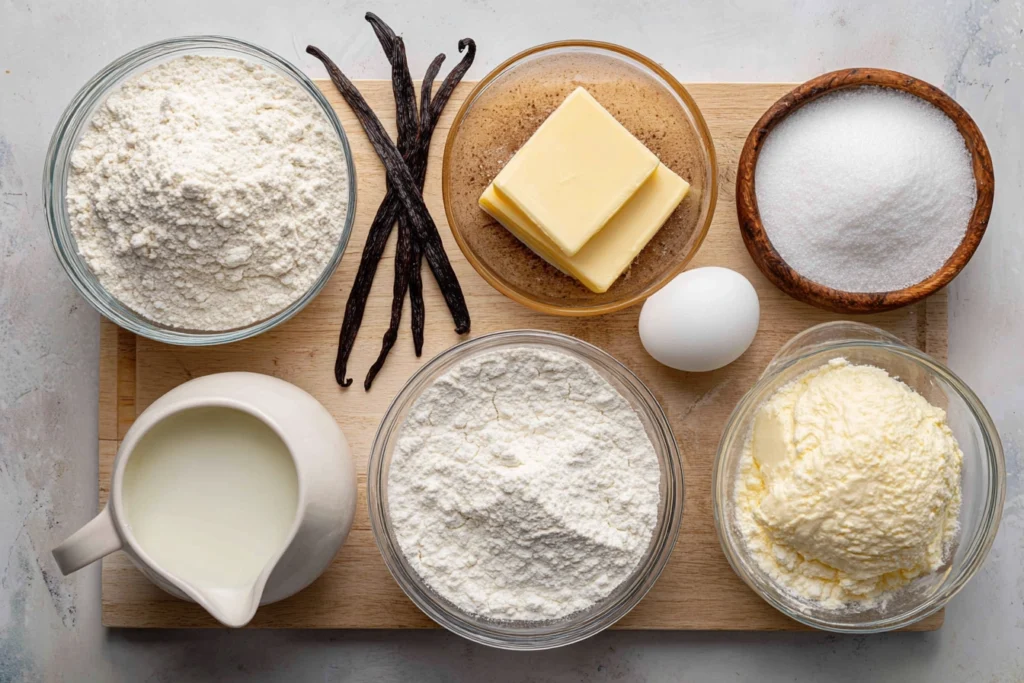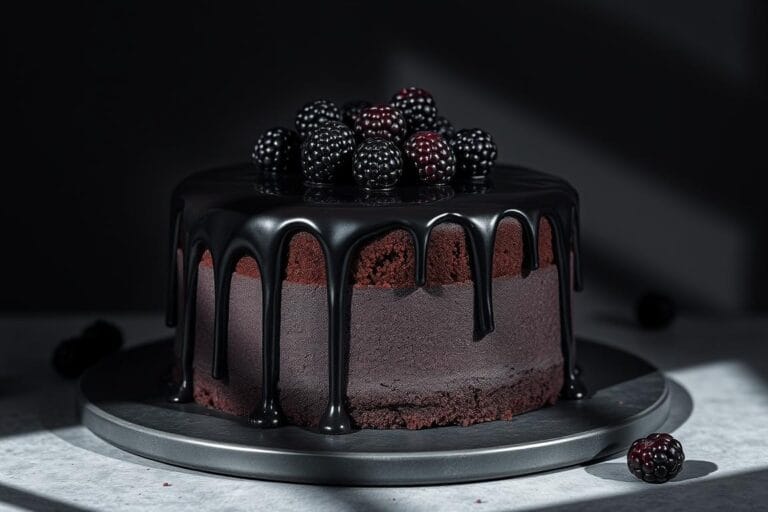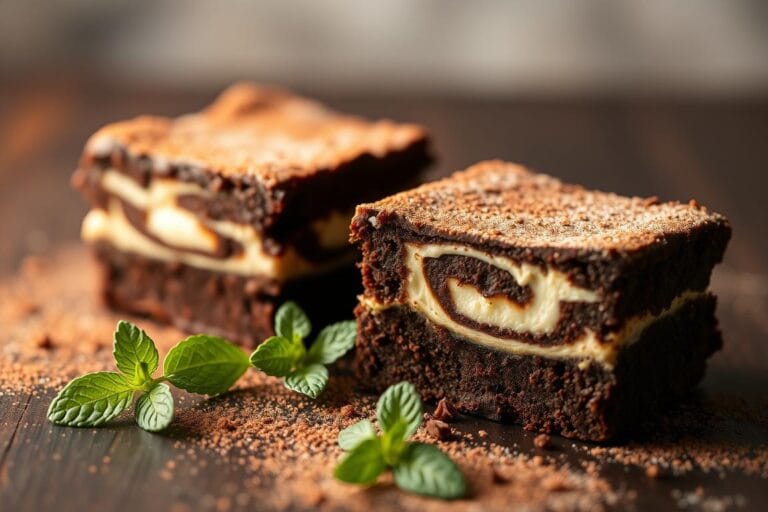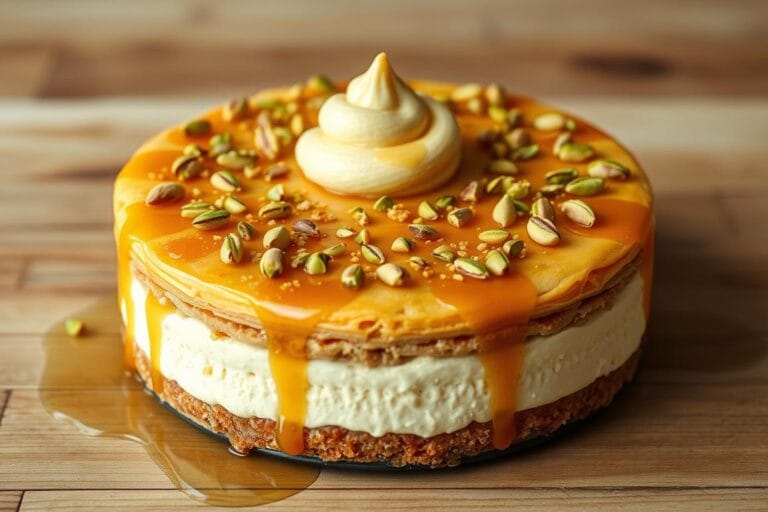Vanilla French Beignets: Light, Airy, and Irresistibly Golden
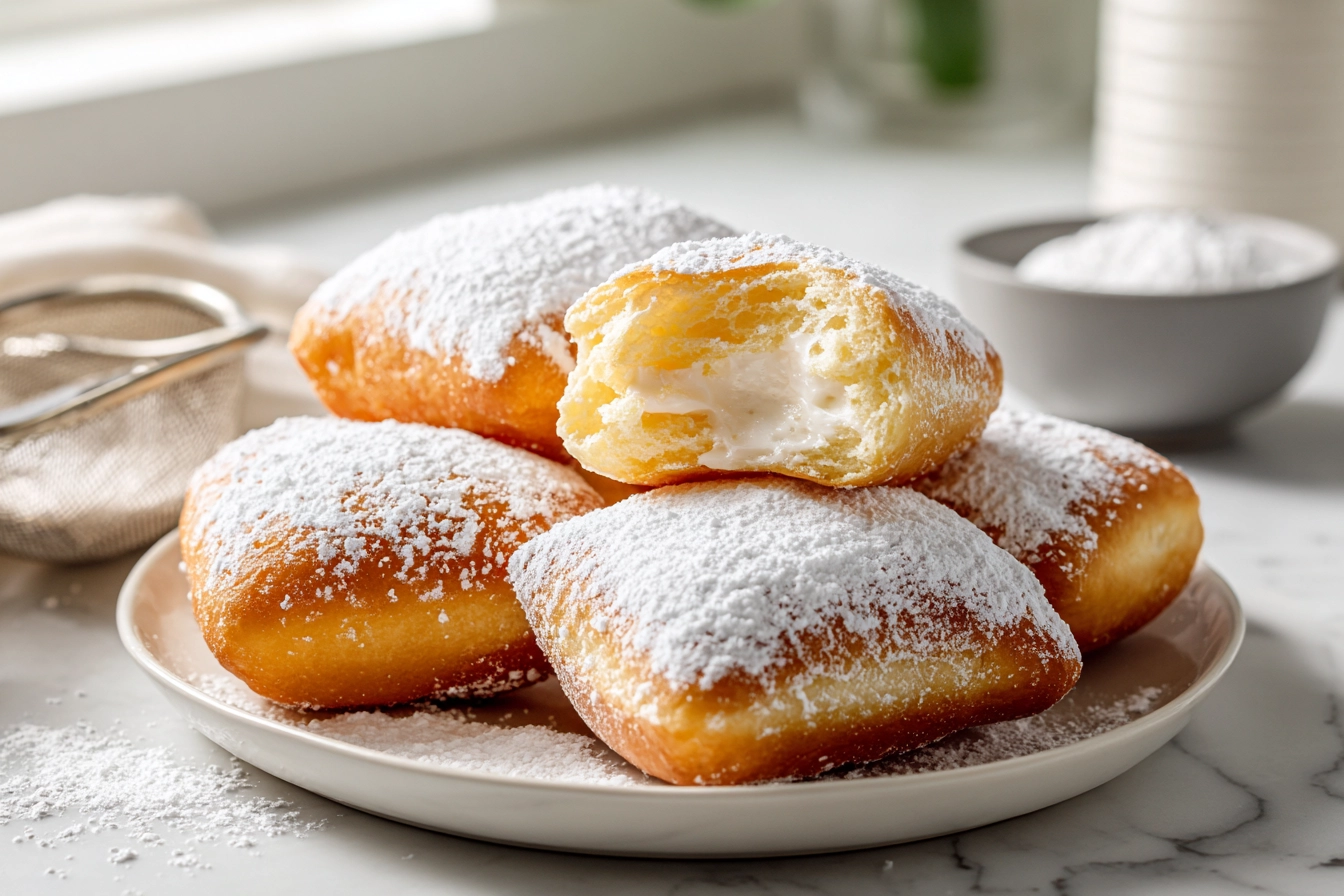
If you’ve ever strolled through the French Quarter in New Orleans, you know the feeling—the sweet scent of fried dough, the powdered sugar floating in the air, and that first bite that feels like a warm hug. That’s the magic of vanilla French beignets, a treat that turns even the simplest morning into something special. These delicate, pillow-soft pastries are fried to golden perfection and dusted with a blizzard of powdered sugar. The hint of vanilla adds a comforting aroma that makes them unforgettable, whether you’re making them for brunch or a weekend indulgence.
Table of Contents
What Are Vanilla French Beignets?
Vanilla French beignets are airy, deep-fried pastries with roots in France and a heart in New Orleans. Traditionally made from yeast dough, they puff up when fried, creating a crisp exterior and a soft, hollow center. Think of them as the French cousin of doughnuts—less dense, more delicate, and without a glaze.
The addition of vanilla takes these classic pastries to another level. Instead of a plain dough, vanilla-infused beignets offer a richer aroma and a slightly sweet flavor that pairs beautifully with coffee or a cup of hot chocolate. In the U.S., they’ve become a symbol of Southern comfort and weekend breakfasts that linger a little longer than planned.
Why You’ll Love This Vanilla Version
There’s something undeniably cozy about the blend of warm dough and vanilla. You’ll love this version because it’s both classic and elevated. The texture is light yet satisfying, and the flavor walks a perfect line between sweet and subtle.
These homemade beignets are made for lazy Sunday mornings or special brunches. They’re versatile—you can serve them with a dusting of powdered sugar for simplicity, or get creative by topping them with honey, cinnamon sugar, or a drizzle of chocolate. If you’re hosting guests, these pastries will make you look like a pro baker without requiring fancy tools.
And unlike store-bought pastries, you control every element—the freshness, the sweetness, and even the type of oil you fry them in. The result? A batch that tastes just right every single time.
Ingredients & Equipment You’ll Need
Ingredients
- 2 ¼ teaspoons (1 packet) active dry yeast
- ¾ cup warm milk (about 110°F)
- ¼ cup granulated sugar
- 1 large egg
- 2 tablespoons unsalted butter, melted
- 1 teaspoon pure vanilla extract
- 2 ½ cups all-purpose flour (plus more for dusting)
- ½ teaspoon salt
- Vegetable oil, for frying
- Powdered sugar, for dusting
Equipment
You’ll need a stand mixer with a dough hook (or a sturdy spoon and strong arms), a deep pot or Dutch oven for frying, a candy thermometer to monitor oil temperature, and a slotted spoon for removing beignets safely. Lay them on a paper towel-lined tray to absorb excess oil before the sugar snowstorm begins.
Step-by-Step Preparation & Cooking Method
Activate the Yeast
In a small bowl, combine warm milk, yeast, and sugar. Let it sit for about 10 minutes until it looks foamy. That’s how you know your yeast is alive and ready to work.
Mix the Dough
Whisk in the egg, melted butter, and vanilla extract. Gradually add the flour and salt, mixing until the dough comes together. If you’re using a mixer, knead for about 5 minutes on medium speed. The dough should feel soft and slightly tacky, not sticky.
Let It Rise
Transfer the dough to a greased bowl, cover it with a clean towel, and let it rise in a warm spot for about 1 to 1½ hours. When it doubles in size, it’s ready.
Shape the Beignets
Roll the dough out on a floured surface to about ¼ inch thick. Cut into 2-inch squares or use a round cutter if you prefer. Rest them for another 15 minutes while you heat your oil.
Fry to Perfection
Heat vegetable oil in your pot to 350°F. Fry the beignets in small batches for about 1 to 2 minutes per side, until golden brown and puffed. Don’t overcrowd the pot—each one needs space to expand. Remove with a slotted spoon and drain on paper towels.

The Finishing Touch
While still warm, shower them generously with powdered sugar. Serve immediately for that melt-in-your-mouth texture.

Serving Suggestions & Flavor Pairings
Nothing beats a fresh batch of beignets with a hot cup of café au lait. But you can also make them your own with fun toppings or sides. For a fruity twist, try a spoonful of raspberry jam or lemon curd. If you’re leaning toward dessert, drizzle melted chocolate or caramel over the top.
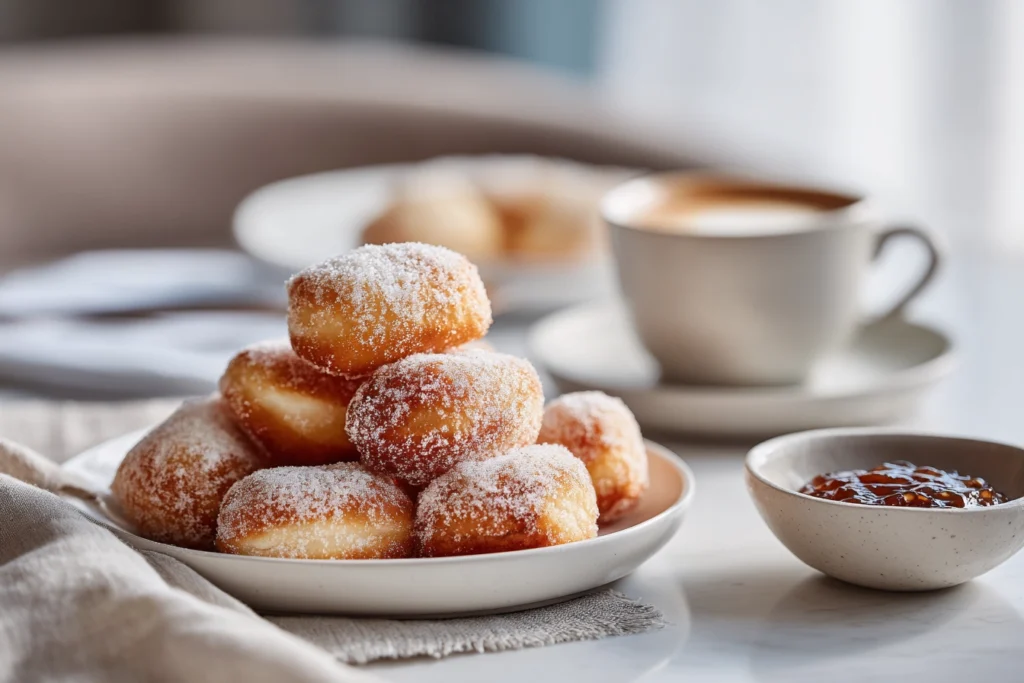
For a brunch platter, pair these vanilla French beignets with scrambled eggs, fresh berries, and cold orange juice. Their crisp, sweet finish balances savory dishes beautifully. And if you’re feeling nostalgic for New Orleans, dust them extra thick with powdered sugar and enjoy them over newspaper—just like the locals.
Dietary Variations: Vegan, Gluten-Free, Low-Calorie & Halal Adaptations
Everyone deserves a taste of this classic, and it’s surprisingly easy to make vanilla French beignets fit different diets.
Vegan Version
Use oat or almond milk instead of dairy milk, replace the butter with coconut oil or vegan butter, and swap the egg with a “flax egg” (1 tablespoon ground flaxseed + 3 tablespoons water). The result is still fluffy, though slightly denser.
Gluten-Free Option
Substitute the flour with a gluten-free all-purpose blend that includes xanthan gum. You may need an extra tablespoon or two of liquid to keep the dough soft. The flavor remains delightful, though the texture might be a bit more cake-like.
Low-Calorie Adaptation
Instead of deep frying, you can air fry or bake the beignets at 375°F until golden. Brush them lightly with oil to mimic the traditional crispiness. They won’t puff as much, but they’ll still satisfy that sweet craving.
Halal Version
Use halal-certified vanilla extract and frying oil. Everything else in this recipe naturally aligns with halal dietary standards.
These variations allow you to share the joy of vanilla French beignets with everyone at your table, regardless of dietary needs.
Storage, Make-Ahead & Reheating Tips
Beignets are best enjoyed the same day they’re made, when the exterior is crisp and the inside is light as air. But if you do have leftovers, store them in an airtight container at room temperature for up to two days. To reheat, pop them in a 350°F oven for about 5 minutes—just enough to revive their texture. Avoid microwaving; it makes them chewy.
If you want to plan ahead, you can prepare the dough the night before and refrigerate it. Let it come to room temperature and rise before frying. You can even freeze unfried dough squares for up to a month—just thaw, rise, and fry when the craving hits.
Nothing feels quite as comforting as a plate of warm vanilla French beignets, dusted with sugar and shared with people you love. Whether you fry them for a cozy weekend breakfast or an elegant brunch, they bring a taste of French tradition and Southern soul to your kitchen. Once you’ve tried these golden pillows, you’ll understand why they’ve remained a timeless favorite for generations.
Frequently Asked Questions
What is the difference between beignets and doughnuts?
Beignets and doughnuts are both fried pastries, but vanilla French beignets use a yeast-raised dough that puffs up into an airy pillow when fried, whereas many doughnuts are denser and use baking powder or a different dough type. In beignets, the interior is light and somewhat hollow, offering a crisp exterior and soft inside that melts in your mouth.
Why didn’t my beignets puff up properly?
If your batch of vanilla French beignets didn’t puff, it could be because the oil temperature was too low, the dough didn’t rise fully, or the yeast wasn’t fully activated. Make sure the oil reaches around 350-375°F before frying, let the dough double during its first rise, and confirm the yeast mixture is frothy before mixing the dough.
Can I make beignets without yeast?
Yes — you can make a quick no-yeast version using baking powder or a ready dough, but it won’t deliver the same airy texture as traditional vanilla French beignets. The flavor will be there, but you’ll notice a denser, more doughnut-like interior instead of the classic light and fluffy structure.
How do I store and reheat leftover beignets?
Since vanilla French beignets are best fresh, you should store leftovers in an airtight container at room temperature for up to two days. To reheat, pop them into a 350°F oven for about 5 minutes to refresh the crisp exterior. Avoid the microwave as it tends to make them soggy.
Get inspired with more mouthwatering recipes! Follow me on Facebook, Pinterest, and subscribe to YouTube for new cooking ideas every week.
Print
Vanilla French Beignets
- Total Time: 1 hour 50 minutes
- Yield: 12 beignets 1x
Description
Light, airy, and golden fried pastries dusted with powdered sugar. These Vanilla French Beignets are classic New Orleans-style treats with a hint of vanilla aroma, perfect for breakfast or brunch.
Ingredients
- 2 ¼ teaspoons (1 packet) active dry yeast
- ¾ cup warm milk (about 110°F)
- ¼ cup granulated sugar
- 1 large egg
- 2 tablespoons unsalted butter, melted
- 1 teaspoon pure vanilla extract
- 2 ½ cups all-purpose flour (plus more for dusting)
- ½ teaspoon salt
- Vegetable oil, for frying
- Powdered sugar, for dusting
Instructions
- Combine warm milk, yeast, and sugar in a small bowl. Let sit until foamy.
- Whisk in egg, melted butter, and vanilla extract.
- Gradually mix in flour and salt until dough forms. Knead until smooth and elastic.
- Cover and let rise 1 to 1½ hours until doubled.
- Roll dough to ¼ inch thick and cut into 2-inch squares.
- Heat oil to 350°F and fry beignets until golden, 1–2 minutes per side.
- Drain on paper towels and dust with powdered sugar before serving.
Notes
- For best results, serve immediately after frying.
- If desired, freeze dough squares and fry later.
- Avoid overcrowding the pot to ensure even cooking.
- Prep Time: 1 hour 30 minutes
- Cook Time: 20 minutes
- Category: Dessert
- Method: Frying
- Cuisine: French
Nutrition
- Serving Size: 1 beignet
- Calories: 190
- Sugar: 8g
- Sodium: 60mg
- Fat: 9g
- Saturated Fat: 2g
- Unsaturated Fat: 6g
- Trans Fat: 0g
- Carbohydrates: 23g
- Fiber: 1g
- Protein: 4g
- Cholesterol: 25mg
What Are Our Readers Saying?
There are no reviews yet. Be the first one to write one.

